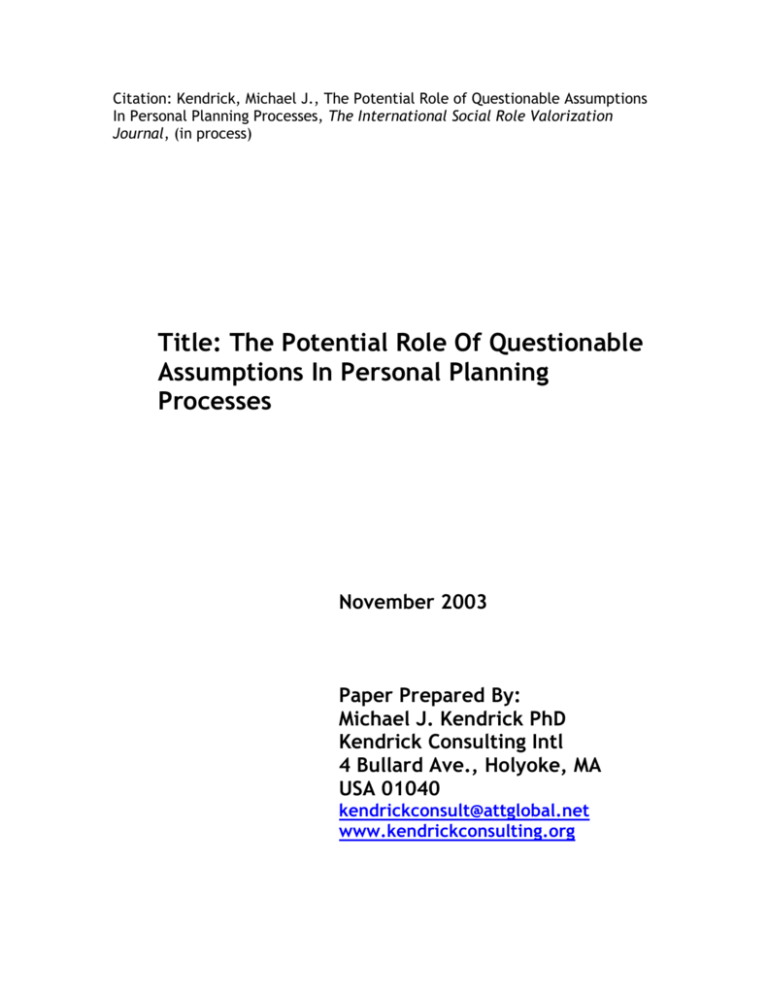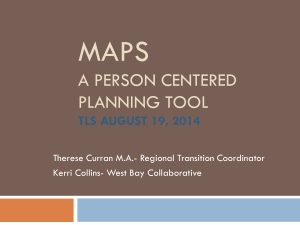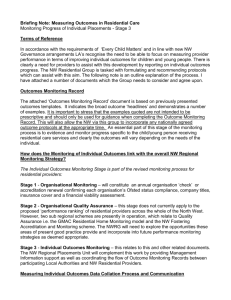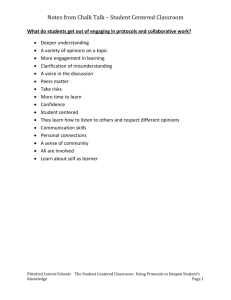Assumptions And Personal Planning
advertisement

Citation: Kendrick, Michael J., The Potential Role of Questionable Assumptions In Personal Planning Processes, The International Social Role Valorization Journal, (in process) Title: The Potential Role Of Questionable Assumptions In Personal Planning Processes November 2003 Paper Prepared By: Michael J. Kendrick PhD Kendrick Consulting Intl 4 Bullard Ave., Holyoke, MA USA 01040 kendrickconsult@attglobal.net www.kendrickconsulting.org Introduction In recent decades “person centered service” has been heralded by many people as constituting a kind of high order paradigm shift. This claim is certainly not without some merit, but it may both be overstating what has actually been accomplished in people’s lives, and it may not fully acknowledge how much about present practice is not really all that different from the practices that preceded it, notwithstanding that it has been relabeled as being “person centered”. One key fundamental in this regard is the fallibility of human judgment in regards to the propensity to make all manner of either false or at least misleading assumptions about people. In due course, these shaky assumptions become the foundation for new models of support that are simply not as optimal as they should be. What follows are some illustrative examples of the kinds of assumptions that can create this kind of mischief. 1) Planning For All Time Though it may seem strange on reflection, much of what some people may think of as “person centered planning” is guided by the often unspoken premise that what is being created is likely to be in place for the remainder of people’s lives, rather than to have a future of uncertain duration. This may come about due to the understandable wish that everything in life be settled once and for all. Nevertheless, the reality of life is that one can only settle matters that are resolvable at the moment, and there is really no way of knowing what life will eventually bring about that completely upsets our assumptions about the future. A more realistic assumption would be to resolve, as best one can, that which can be resolved at a given moment, knowing full well that many decisions can only be made at the time they are needed. 2) Planning On The Basis Of A Building It is all too common for many people to first envisage, or already have, a building, and then cast about for how to best use it in regards to a given person. This is seen most often in residential services, but could also occur in regards to other domains of people’s lives. Starting with such assumptions, unfortunately, makes the person’s life and future lifestyle contingent on the ongoing use of the building, rather than being driven by who the people really are and what they most need. Conceivably, that person could have their needs met in all sorts of other ways that do not involve using a given building. If so, then making the building a “given”, preempts all of these possibilities independent of their merit. A better place to start is with as few “givens” as possible so that the people involved can be free to imagine the future unburdened by unnecessary and inhibiting constraints. 3) Planning Based Upon The Monies That Are Available Or Unavailable It is no surprise that when one starts with a given amount of money in mind, that the service model that is formed is tempted towards spending that money, whether or not that is actually what people need. The same preemptive dynamic is also at work in instances where people stop imagining and evaluating options that they believe could not get funded. In both instances, the money becomes the fundamental platform upon which personal needs get examined rather than to examine people’s needs in their own terms. A more desirable approach would be to suspend consideration of costs until it is clear what is going to be most fundamental to a person’s well-being. Even if these conclusions cannot find funding, it does not mean that they are not valid and important. Often enough, what is most fundamental to people has only a tangential rather than a predictive relationship with money. 4) Planning On The Basis Of Standardized Service Models It is important to recognize how difficult many people find it to step outside the service models they have seen, and to imagine futures for people that could involve approaches that do not follow conventional service designs and practices. Rather than ask the question in a more open ended way as to what is most needed by a person, many people actually start with a service model in mind, and see their task as being one of tailoring it to better accommodate the person i.e. “what kind of day program is needed?” as opposed to “what kind of lifestyle does the person need or want?”. In some instances, the person or the people around them are so enthused about a particular model, that they may not realize that models should fundamentally evolve from people rather than have people’s lives be fitted to a pre-existent model. In this regard, it would be better to start with the assumption that no presumptive model exists, and whatever model arises from planning should draw its authority from who people are and what are their actual needs. 5) Planning “For” Rather Than “With” People In reality, despite all the talk of person centered approaches, most service models are created before people actually arrive on the scene. This has its roots in the principal authority and control of service design decisions being carried by parties other than the person being served. The end result is that services are ultimately designed and decided upon by people other than the person, albeit involving some manner of consultation with the person. Nonetheless, it is very hard to justify the imposition of service solutions “on” or “for” people as being “person centered”, when the person is unable to originate the crucial essence of service model. A better approach would be to proceed on the basis of a rigorous ethic of only developing a service model “with” people, and to ensure that, at the very least, all decisions in its formation are joint ones. It is also important that people recognize how much they may “need to be needed” and face this squarely. 6) Planning On The Basis Of What Is Immediately Practical As has already been said in regards to monies and standardized service models, most people have at least some difficulty freeing themselves from their conformity to what is already in place. This is particularly true in their abilities to picture what they have not yet seen, or even heard about. Yet, often enough, what people may most need may not be in place, and may have to be created “from scratch”. In many cases, the “dream” of the person may be valid, but simply not immediately feasible, quite apart from the additional burden of being difficult to enlist support for. These are certainly temporary constraints that will exact a toll, yet yielding to these may itself be a disservice to the person and their dream, as one should remain open to the possibility that these obstacles could one day be removed. In the beginning, one may be quite naturally baffled by how to bring things into reality, but it should be remembered that it is precisely in not yielding to immediate practicalities that assists with the formation and “birthing” of otherwise valid models of what is ultimately possible in a person’s life. Naturally, some hesitancy derives from not wanting to raise people’s hopes unfairly, but this concern can be balanced by being realistic while still upholding the dreams of people. 7) Planning On The Basis Of How Professionals Or Others In Authority View Needs And Solutions There is no doubt that there are many people in authority whose intentions and commitment to people are exemplary. Yet, when it comes to the evolution of a unique service arrangement that is well tailored to a person’s needs and wants, it should be routinely presumed that professionalized formulations are not the only ones that are ultimately valid. Otherwise, the person will be hemmed in by what is comfortable and conventional for professionals, rather than to concentrate on what is actually ideal for the person. A better approach would be to remain open to professionalized solutions, but emphasize that answers that discomfit professionals and authorities may conceivably be exactly what is needed. After all, many of what are now today’s common practices amongst authorities and professionals were at one point alarming to them, and outside of their experience. 8) Planning On The Basis Of “Vacancies” Or Other Immediate “In Hand” Opportunities Much as in the case of starting with a building as a basic parameter for personal planning, many people may be tempted to “take the bird in the hand” rather than to delve more deeply into what is actually deeply needed. Such pragmatism is understandable, particularly when people may be desperate for a solution. Nonetheless, taking the decision to accept a less than ideal option is quite a different matter from formulating the ideal in the first place. When such pragmatism preempts the necessary process of “imagining better” and testing the “better” for its validity, then the person has been cheated out of the possibility of dwelling on an optimal model for their life. It is most certainly true that many people might never fully realize their dreams, and so it is all the more important that the serious consideration of people’s authentic life potential not be postponed or distorted by what may prove to be simply an available option rather than a desirable one. 9) Planning With A Lack Of Sufficient Consideration For The Unseen Potential That May Still Be Hidden In People’s Lives One of the challenges in searching for the full potential of the “person”, is that what is a “person” is an ever unfolding reality, and there well may be all sorts of depths in a person that may be latent in them, but not yet manifested. Consequently, both the person and those who know them may periodically be surprised by what they become or do. Naturally, it is a quite difficult thing to deliberately seek out the hidden and unknown aspects of a person, but one at least has to be mindful of these, particularly if these link to the deeper needs and longings of the person. In this regard, it is useful to be “sensibly unrealistic” in looking past what people have already been, to the more elusive, but powerfully formative question of what they might some day become. Given that so many people are both underappreciated and devalued, it is a quite practical advantage, if not a necessity, to grant to them at least the possibility that there is a lot of hidden potential in their lives. “Person centeredness” cannot be just about the person we have already seen, there must be allowances made for the person who might yet be. All too often, the eventual lives of people stand as a testimony to how wrong others have been about them. Naturally, we want to avoid such an error. 10) Seeing Residential Needs As The Defining Needs Of People It occurs with great regularity that people place the issue of where people sleep as being the starting point for personal planning. This has the effect of making residential issues trump all other issue in their lives in terms of their relative order of importance. Consequently, their needs become “residentialized” i.e. they are thought to need a residential service. Consequently, the thinking processes involved become unduly fixated on settling this matter. In reality, the actual needs of the person may be addressable with models that do not requite their placement in a residential service whatsoever. For this reason, it is usually better to first examine the overall life purposes and life interest needs of the person, in their own terms, and see if in fact what is crucial is actually obtaining a residential service. Placing people whose primary needs are not residential into an unneeded residential service may well be tantamount to ignoring the person. The expression, that “to a hammer all problems look like nails”, is a reminder to all of us to be sensitive as to what we define as the problem, or we may unwittingly convert people’s lives into the problems we want to solve, rather than create what they actually need with them. 11) Expecting People To Be Articulate About Their Needs and Wants It is not all that unusual that the processes surrounding the planning for people’s lives are created on the assumption that the people being focused upon will be forthright and articulate about their needs and wants. Undoubtedly, in some instances, this is precisely what occurs. Nonetheless, for most people, what is deeply personal and at the core of their existential outlook, may be very hard for them to capture and express, particularly to strangers. People are often a mystery to themselves, and may be stymied by the task of ordering their wants and needs into a communicable offering to a planning process that may not be of their design at all. Many people are intently uncomfortable about revealing their innermost desires and needs to even people they love and trust, so expecting that this will occur without difficulty when dealing with “rented strangers” is a risky assumption. Even if people are seemingly expressive of their needs and wants, should these be assumed to be the whole story, given that many people may be reluctant to share wishes and hopes that they feel others ought not know about? Lastly, the formation of identity is a constant search, and there may be many times when people have not yet found the answers they are seeking. They cannot obviously share anything at these points other than their uncertainty. 12) Planning On The Basis That People Actually Need Or Want A Formal Planning Process; “Person Centered” Or Otherwise Many advocates of “person centered” planning methodologies are often enthusiastic about seeing their techniques be widely applied, often on a wholesale basis, on the assumption that their use is always going to be benign. Though it may seem strange to point this out, it is quite conceivable that a person could have a perfectly good life, and many desirable “person centered” outcomes, without the use of any formal planning methodology whatsoever. In fact, it is often only the clients of human services that are expected to subject themselves to such unusual processes. Ironically, given the intent to focus on the uniqueness of people, many of these processes are themselves quite standardized, methodologically prescriptive, bureaucratically invasive, and may not always specifically allow for the fact that people may want to design their own processes, or simply opt out. A better approach would be to start right at the beginning, and inform people that the use of formal planning is only one option, and may not either be necessary or needed, quite apart from being desirable. “Person centeredness” is probably vastly more important in the grand scheme of things than is any formal planning process, so it is important that this be given some weight. Conclusion The preceding examples of common mistaken assumptions are not at all exhaustive, as there are simply too many ways to be incorrect in our judgments about others. Rather, the point of these is simply to be illustrative of why we must take great care with people’s lives. We must also be willing to see that there is a deep continuity between the misjudgments of people with disabilities by past eras, and the repetition of this same mistake in the present. Human nature has not been suddenly transcended because we now claim that we are “person centered”. People of other eras were undoubtedly as equally convinced that they were above such failings as we might believe about ourselves.











